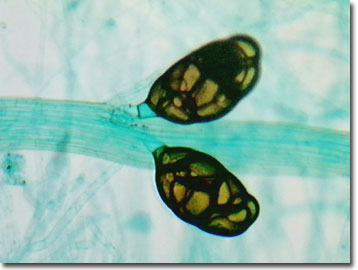Brightfield Digital Image Gallery
Moss Bulbils
In similarity with other green plants, the mosses of the phylum Bryophyta are eukaryotic, utilize chlorophyll a and b, as well as xanthophylls and carotenoid pigments for photosynthesis, store starch, possess pectin-cellulose cell walls, and display open mitosis. Mosses have a sporic (diplohaplontic) life cycle that is oogamous, and may represent the link between thallophytes (flat, stemless and rootless plants such as liverworts) and cormophytes (plants with distinct leaves, stems, and roots).

View a low magnification image of moss bulbils.
The haploid gametophyte is the dominant phase of the moss life cycle and is the familiar small green plant occurring in the woods in a lush bed of green moss. Germination into the gametophyte plant is triggered by incident light on the haploid moss spore when surrounded by a moist environment. The protonema is a developing filament of haploid cells that sprouts from the spore wall and resembles a filamentous green alga. Protonema is of Latin origin meaning early worm, perhaps because of its long, thin form. This stage of the bryophyte life cycle typically lasts from a few days to many months.
From the tangle of branching filaments, bulbils (baby bulbs: clumps of cells that develop from the protonemata) form as brown structures that contrast dramatically against the verdant green beds of many mosses. Bud-like, the aerial bulbs or bulbils will develop into typical parenchymatous moss gametophytes when they reach a favorable environment. Although the parasitic moss sporophyte typically does not reproduce asexually, the host moss gametophyte does, via gemma in gemmae cups, bulbils budding from the gametophyte surfaces, or fragmentation of the branching protonema. Some moss species also exhibit small tuber-like structures on the rhizoids that allow vegetative reproduction. Interestingly, more advanced plants, such as lilies and wild onions, have also adopted the strategy of using aerial bulbils as an alternative means of asexual reproduction.
Contributing Authors
Cynthia D. Kelly, Thomas J. Fellers and Michael W. Davidson - National High Magnetic Field Laboratory, 1800 East Paul Dirac Dr., The Florida State University, Tallahassee, Florida, 32310.
BACK TO THE BRIGHTFIELD IMAGE GALLERY
BACK TO THE DIGITAL IMAGE GALLERIES
Questions or comments? Send us an email.
© 1995-2025 by Michael W. Davidson and The Florida State University. All Rights Reserved. No images, graphics, software, scripts, or applets may be reproduced or used in any manner without permission from the copyright holders. Use of this website means you agree to all of the Legal Terms and Conditions set forth by the owners.
This website is maintained by our
Graphics & Web Programming Team
in collaboration with Optical Microscopy at the
National High Magnetic Field Laboratory.
Last Modification Friday, Nov 13, 2015 at 01:19 PM
Access Count Since September 17, 2002: 9824
Visit the website of our partner in introductory microscopy education:
|
|
